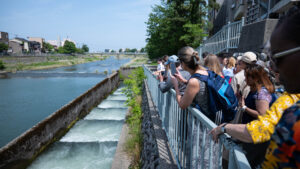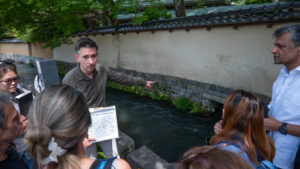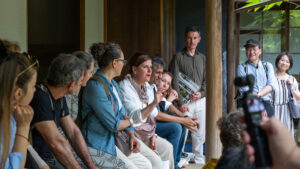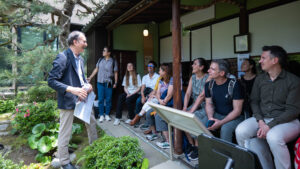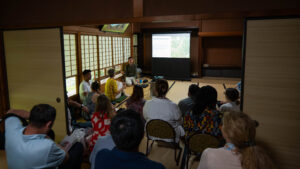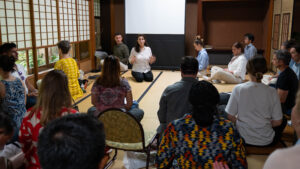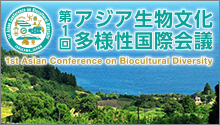On May 21, 2025, as part of the International Symposium on Urban Ecosystem Restoration, an on-site excursion exploring the natural and cultural resources within Kanazawa City was held organized by the United Nations University Institute for the Advanced Study of Sustainability Operating Unit Ishikawa Kanazawa (UNU-IAS OUIK) and Kanazawa City.
Approximately 20 participants, including city representatives and experts from both Japan and abroad, visited and observed Kanazawa’s waterfront environment, cultural and historical landscapes, and conservation and revitalization activities, deepening their understanding of efforts to create a harmonious coexistence of urban nature and culture.
Experiencing Kanazawa’s Water Culture
In the morning, the excursion began with a walk along the Sai River. This river, flowing through the city center, is a beloved recreational spot for residents, and the group visited the Sai River Bridge, which has a history of 100 years. Next, participants observed the Kuratsuki Water canal, developed as an urban water supply, and the revitalized “Seseragi Street,” which was transformed through a project that unsealed a formerly covered water canal. This effort was introduced as a collaboration between citizens and local government to restore the water canal as a natural urban landscape.
Historic Gardens and Urban Biodiversity
At Senda Family Garden, participants experienced the coexistence of samurai culture and urban nature through a tea ceremony. They also learned about the garden architecture that incorporates water features at the Nishi Family Garden, the cultural significance of these sites, and conservation efforts through public-private partnerships. The “Historic Gardens Promotion Plan” for Kanazawa was introduced, fostering hopes for new mechanisms involving citizens and tourists in preservation efforts.
Balancing Tourism and Sustainability
In the afternoon, the group visited Higashi Chaya District, a popular tourist destination in Kanazawa. There, efforts to balance increasing tourist flow with the preservation of local cultural resources were explained. After that, at Shinrensha Temple, participants learned about the roles of Zen and urban nature, especially in a society facing population decline, and discussed the potential for such places to contribute to sustainable urban development.
Participants Feedback
Participants shared positive impressions, including, “I was amazed by how lively and rich the cultural life centered around water is within the city,” and “The involvement of the community in urban renewal efforts was truly inspiring.”
This excursion provided an experiential opportunity to learn about the role of culture and citizen involvement in urban natural restoration, serving as a valuable learning experience ahead of the symposium scheduled for the following day.



